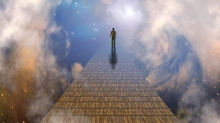Which Came First, the Ouija or the Planchette?
- Dr. Carol A. Pollio
- Sep 12, 2021
- 3 min read

I am often asked about Ouija boards (pronounced whee-ja) and whether they are good or evil. To be fair, nothing is good or evil in that way. Instead, someone's intention while using a divination tool might be good but rarely is it evil. Communicating with Spirit can mean you are contacting something unknown, and that could be a positive interaction or you could connect with something negative. That's why when using any divination tool, including the Ouija, we are taught to set an intention, say a prayer, or call upon our guides for guidance and protection. That one step (depending on your personal belief system) will prevent a negative experience....well, that and not obsessively using any tool, which is always problematic.
That aside, I'm here today to talk about the Ouija board's predecessor, the Planchette. The word planchette is French, meaning "little board." Few realize that the planchette, as pictured above with a pencil attached, was a favorite of Spiritualists as there was direct interaction with Spirit in written form. You simply put your hands on it and automatic writing would ensue. Pretty cool, huh?
The first reference to the planchette is found in 1848 in French monasteries. There, and in French convents, they were used fairly extensively, up to three times a week. So much so that when this fact came to the attention of the Bishop of Paris, he produced an order forbidding them from use. Of course, that simply meant that people secretly continued to use the planchette.
The planchette evolved around the same time as table-tipping and knocking, which were part of the seances conducted regularly during the Spiritualist movement (beginning in the 1840s through the present day). During Victorian times, seances, and the use of the planchette, in particular, meant that men and women could hold or touch hands in the dark, something that was normally frowned upon then. It became a form of entertainment - many of us grew up viewing the Ouija as a parlor game, eventually being sold to the masses as a children's toy.
The Ouija board was patented in 1891, post-dating the planchette by roughly 43 years, at least that we know of, based on the literature. Users reported pages of writing being produced while using it, finding the writing, "was not only perfectly intelligible, but also of a very high order."
In a book published in 1868, it was claimed that millions in the U.S. alone were using the planchette and while some scoffed at others' claims of its accuracy, others called for scientific study of the device to determine its validity. In one case, authors of the book Revelations of the Great Modern Mystery, Planchette, and Theories Respecting It (1868) shared that even after 25 years of careful study, there was still no solid evidence as to what caused the phenomena of the physical knocking, table-tipping, and the movement of the planchette that so many thousands, if not millions have observed.
Interestingly, this same publication compares the physical responses mentioned above with "house-disturbances" (what we would call a haunting or Spirit presence, or even a poltergeist). It's an interesting read, to be sure!
Have you ever tried using a planchette? Perhaps you've tried automatic writing? It would be interesting to hear about your experiences. I certainly have used a pendulum cloth many times, which is based on the Ouija board, and use it regularly to conduct certain types of readings or to communicate with my guides. Just remember, if you do give any divination method a try, to start with your intention, prayer, or guide's protection - I suspect you will be surprised at how interesting and informative using these tools can be!
Read the Book via the Harvard University Library:








































Comments